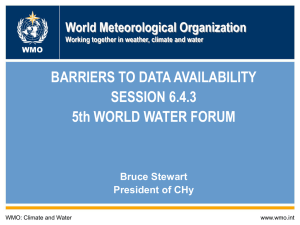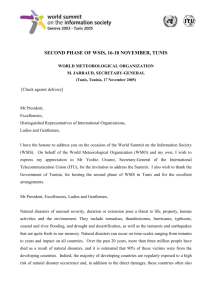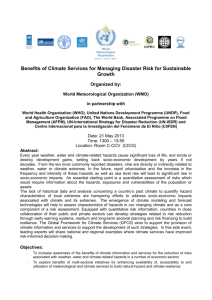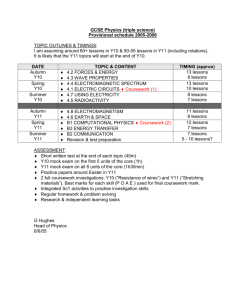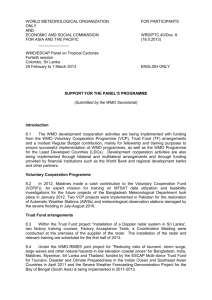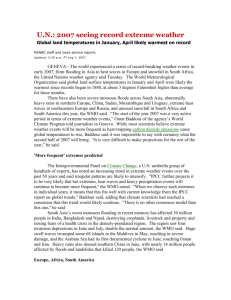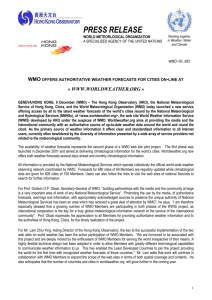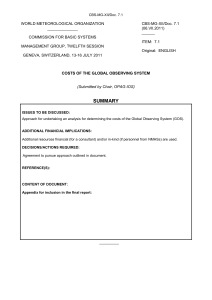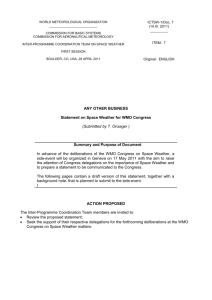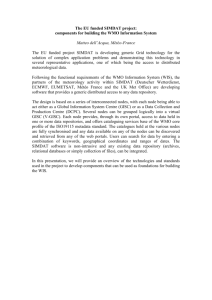Draft Minutes 20140812 1100 PDT_revisions PP
advertisement
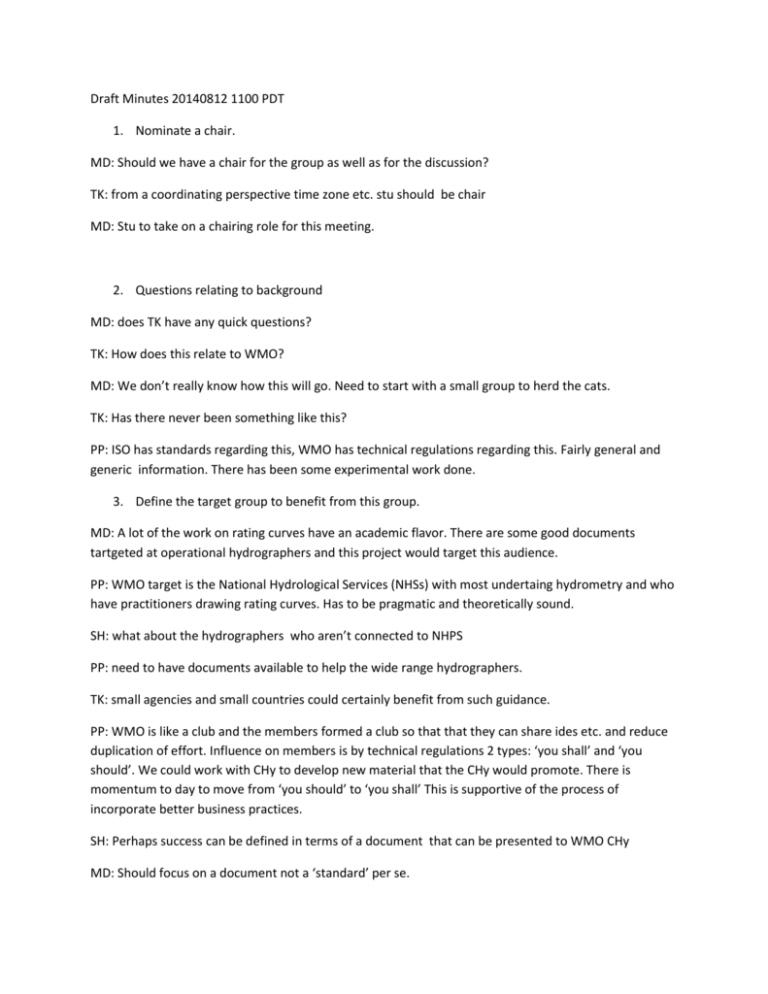
Draft Minutes 20140812 1100 PDT 1. Nominate a chair. MD: Should we have a chair for the group as well as for the discussion? TK: from a coordinating perspective time zone etc. stu should be chair MD: Stu to take on a chairing role for this meeting. 2. Questions relating to background MD: does TK have any quick questions? TK: How does this relate to WMO? MD: We don’t really know how this will go. Need to start with a small group to herd the cats. TK: Has there never been something like this? PP: ISO has standards regarding this, WMO has technical regulations regarding this. Fairly general and generic information. There has been some experimental work done. 3. Define the target group to benefit from this group. MD: A lot of the work on rating curves have an academic flavor. There are some good documents tartgeted at operational hydrographers and this project would target this audience. PP: WMO target is the National Hydrological Services (NHSs) with most undertaing hydrometry and who have practitioners drawing rating curves. Has to be pragmatic and theoretically sound. SH: what about the hydrographers who aren’t connected to NHPS PP: need to have documents available to help the wide range hydrographers. TK: small agencies and small countries could certainly benefit from such guidance. PP: WMO is like a club and the members formed a club so that that they can share ides etc. and reduce duplication of effort. Influence on members is by technical regulations 2 types: ‘you shall’ and ‘you should’. We could work with CHy to develop new material that the CHy would promote. There is momentum to day to move from ‘you should’ to ‘you shall’ This is supportive of the process of incorporate better business practices. SH: Perhaps success can be defined in terms of a document that can be presented to WMO CHy MD: Should focus on a document not a ‘standard’ per se. PP: Agree that we should focus on guidance material as an end game. PP: There are a broad spectrum of practices that don’t follow either WMO or ISO. There is a lot of work to be done. 4. What do we hope to achieve a. Education PP: Finding out the different approaches that are out there? What is the overall process for rating curve development. This can lead to training. TK: it is an education for the part of those taking part. What is the end game? What is the preferred way for rating development? Develop training material based on this preferred way. This can be distributed via the WMO MD: The zero stage of gathering information needs to be a face-to-face gathering of the various experts. Encompassing a wide variety. SH: Is the legacy of case study datasets be an achievement of this group. MD: without specific examples the discussions would lose focus. MD: we should involve someone with experience in experimental design if we are going to do this. PP: There needs to be some aspect of experimental design. TK: before we get into exp design we need to target different types of regimes. PP: maybe it is a tiered process. Before you start the process you want to make sure the design meets your needs. SH: need for intangible data for rating curve analysis. PP: Project X field campaigns are something we need to be congnizant of. TK: is this stage discharge or other surrogates as well. MD: feeling is that we should keep it as simple as possible therefore stage discharge. PP: Initial focus needs to be stage discharge but need to acknowledge that more sophisticated methods may be needed. TK: or how do you know when it is not working. MD: the mantra needs to be do whatever you need to do to understand the hydraulics. SH: The week of September 15th is a meeting of the committee of experts at CHy. PP: Workshops will need to be small in size in order to be effective. People will need to have access to datasets before the workshop. We need to structure the workshops. Funding the whole thing. We need to be flexible in our design. We should have some sort of overall design in place. MD: Is there any merit in trying out ½ doz datasets from wider group to evaluate how diverse the results are? PP: doing it blind means doing over a wide variety of conditions. Need to partition case studies according to geography. TK: There are hard problems to solve but we want to avoid problems that are a mess. MD: can withhold data for validation PP: this gets into experimental design. What is due to skill vs. technique? PP: We don’t need formal partnership – can continue on ad hoc basis. TK: comfortable with communicating with USGS.Is it worth our time to get WMO to buy on. PP: Claudio thought it would be good if we worked on what needs to be done and then we share that with WMO. SH: ACTION ITEM to distribute Jonsson et al. paper. MD: We should set up a name that can be recognized by people we need to talk to. ACTION ITEM MD MD: Need to do a worldwide review PP: review is available on project X website. MD: Maybe we should have a sharepoint site for minutes and documents. TK: Google Drive PP: Moodle SH: NASH wiki ACTION ITEM: SH PP: ACTION ITEM share Project X lit review PP: ACTION ITEM PP to brief Harry Lins (President of CHy) MD: Worthwhile to have a few paragraphs to go to the meeting. PP: We could add to the few paragraphs an annex of the original document, which might need to be adjusted somewhat based on our discussions during this teleconference. ACTION ITEM TK to prepare draft of WMO submission by end of August. SH: ACTION ITEM to distribute recording of first meeting. MD: need to re-draft notification to wider reference group. Need to expand wider reference group. There was another individual identified for Europe. Need to update notice to reflect today’s conversation. PP: What about Asia? TK: Africa and Latin America? TK: did lit review find a wide range of different approaches. PP: it was a “learned” literature review not a practical review. PP: Could we draft a list of who is on the list? Action Item SH to distribute list extended members. Next Meeting Wednesday August 27 1100 PDT (UTC-7) 1200 MDT (UTC-6) 0600+1 NZST (UTC+12) 2000 CEST (UTC+2) 1800 UTC.
